Email automation is a total game changer. Imagine every interaction with your audience being timely, on point, and strikingly personal – that’s possible with automated email campaigns! Streamlining the process of emailing will enable businesses to continue with a constant and interactive dialogue with their customers without having to manually send emails.
The various automated email campaigns are the magic ingredient to improving customer engagement and boosting sales. They are like having a team of marketers that never sleeps to make sure that the right message is delivered to the right person at the right time. From welcoming a new subscriber to rekindling the interest of a long lost customer, these campaigns span across a large spectrum of interactions, each one designed with the recipient in mind.
This deep dive will cover different types of automated email campaigns that can revolutionize the way you communicate with your audience. Regardless if it’s a subtle push to finalize a purchase, birthday wishes with a special discount, or an informative piece that makes the reader see your brand as an expert, each campaign type has a role in your marketing strategy. And the best part? Sendpad is one of the platforms that makes managing such campaigns unbelievably simple and productive, leaving you to do what you do best: growing your business.
1. Welcome Emails
Welcome emails are like a digital handshake – a vital first contact between a brand and its new subscriber or customer. They are not just an initial greeting, but instead the beginning of the history of your relationship with your target audience. Basically, welcome emails are designed to confirm their subscription, to introduce your company, and to define the standards for the future communications.
For optimal impact, your welcome message should:
- Welcome new members to your group.
- State why they have been sent your message.
- Detail the perks and content they will receive as members, emphasizing the benefits.
- Reflect the distinctive personality of your brand.
- Encourage visitors to explore your content more or learn more about your company.
- Lead new contacts to the next step so that they continue to interact with your brand.
- Surprise the members with something extra, e.g., a free voucher or a downloadable content.
- Tell them where to find you on social media.
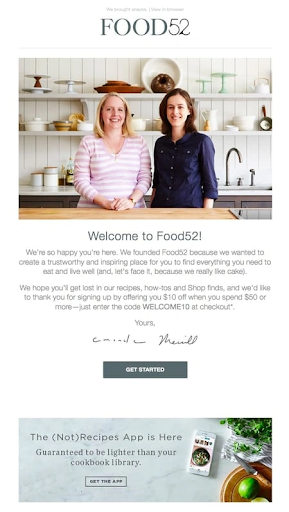
2. Onboarding Emails
Onboarding emails are not just a set of automated messages; they are the beginning of your customer’s relationship with your brand. These emails are critical not only in the introduction of new users to your product or service but also in the establishment of the tone in your ongoing relationship. It is all about creating that first impression and following up on that. They onboard new users, show them the main features of your product or service, and allow them to understand the benefits they can get from what you provide. This first contact is crucial for user retainment and interaction.
To enhance the user experience, an onboarding email should incorporate:
- Simple Steps for Familiarization: Provide simple-to-understand, step-by-step instructions to the basic workings of your product.
- Getting Started Tutorial: Link to an introductory tutorial or give a guide that could be downloaded for beginners to understand the basics..
- Quick Wins: Provide simple, fulfilling activities that users can do by themselves, which then gives a sense of accomplishment right away.
- Product Capabilities Examples: Present real-life instances or case studies that would show what your product can do for them.
- Customization Aids: Provide cheat sheets or templates that users can use to personalize their workflow.
- Social Proof: Showcase testimonials or case studies from other users, especially those who have reached the same goals that the new user wants to achieve with your tool.
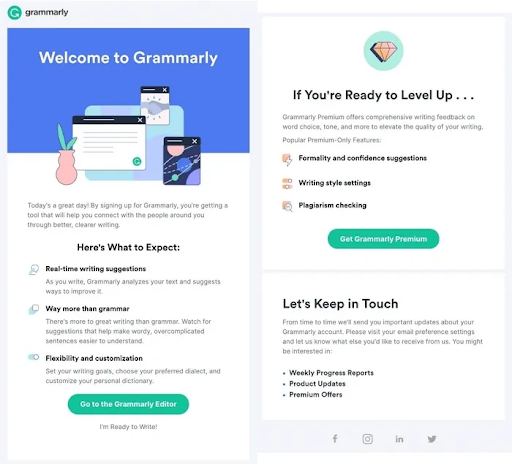
3. Transactional Emails
The least considered but highly important transactional emails are the backbone of customer communication in e-commerce. They are not typical marketing messages but instead are personalized, triggered responses to customer actions. Consider them as the hard workers of your email strategy, bringing important details like purchase confirmations and receipts right to your customer’s inbox.
Examples of transactional emails and share practical tips to maximize their effectiveness.
- Purchase Confirmation Emails: These are the virtual receipts of a customer’s order. It is not just a receipt; it is the first post-purchase touchpoint. A good purchase confirmation email should contain order specifics, estimated delivery time, and a special thank you note. Pro tip: Insert a personal touch by including product care suggestions or a teaser of other products.
- Shipping Notifications: When an item is on its way, a shipping notification email makes sure that the customer is well informed and gets excited about their purchase. These emails must include a tracking number and an expected delivery date. Tip: Why not sprinkle a little bit of expectation? A short note such as “Your order is on its way! Get ready to enjoy your purchase” can improve customer satisfaction.
- Password Resets: A must, but never fun – password reset emails should be simple and safe. Clear instructions should be provided on how to reset the password easily. Tip: Make sure that these emails are delivered quickly and keep security a priority by not using direct links. In turn, direct clients with a simple process.
- Payment Failure Notifications: Sometimes, transactions fail. Payment failure emails are vital in enabling customers to resolve issues without irritation. They should be transparent, supportive, and give straightforward actions to be taken to complete the payment. Tip: Empathy works wonders here. Admit of the inconvenience and provide help for a smooth outcome.
- Feedback Requests: Customer feedback is critical after the sale. This transactional email can improve your service and product offerings. Make it simple, sweet, and straight to the point with a clear call-to-action. Tip: Providing a tiny reward for feedback may boost response rates.
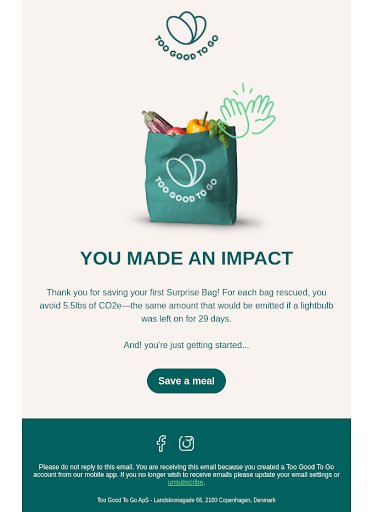
4. Cart Abandonment Emails
Abandoned carts are not bad signs but are instead an opportunity for clever marketers. Solving this problem is not only in lost sales recovery; it is in identifying and reacting to customer behavior.
To ensure your abandoned cart emails effectively bring customers back:
- Cart Reminder: Remind customers of items they left behind immediately, or show them similar items that they have viewed which are now discounted.
- Product Recommendations: Recommend other products they may like.
- Purchase Incentives: Give persuasive reasons to finish the purchase, such as free shipping, fast delivery alternatives, or an easy return policy.
- Special Offers: Lure them with a special discount or a special offer.
- Inventory and Sale Alerts: Notify them of low stock items or about an ending limited time sale.
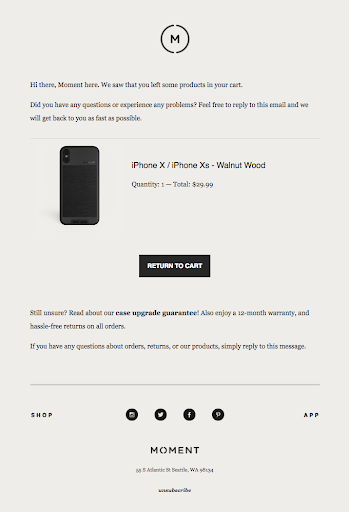
5. Re-engagement Emails
Re-engagement emails are a strategic communication technique to reestablish connection with the subscribers who have been inactive or disengaged over time. These emails seek to rekindle interest and engagement among the recipients, bringing them back to regular interaction with your brand or services.
The most effective re-engagement emails typically include:
- A Warm, Missed-You Message: Illustrating a kind of friendly voice to say that they have been missed.
- Welcome Back Incentive: Providing them with a special deal, like a welcome back offer or an extended trial period, to make them return.
- Unsubscription Notification: Notifying the subscribers that they will be unsubscribed from the mailing list unless they claim their interest in receiving your emails.
- Feedback Invitation: Asking for their ideas via a feedback form or customer satisfaction survey in order to better understand what they require and prefer.
- Reminder of Lost Benefits: Emphasizing the pros and benefits that they will lose if they decide to cancel their subscription or if their account is left dormant.
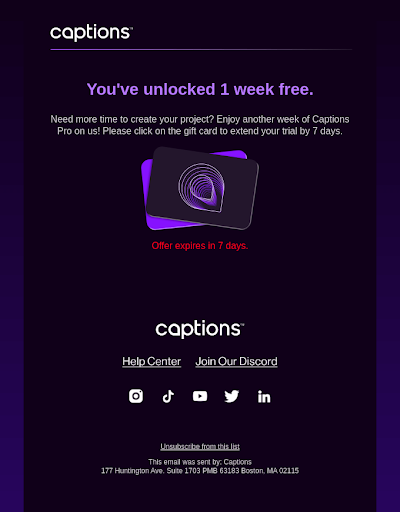
6. Win-Back Emails
Win-back emails are essential tactics created to bring back customers that haven’t made a purchase in a long time. The purpose of these emails is to remind the customer of your brand and to rekindle your products or services.
- Rekindling Customer Interest: The main aim is to bring back the lost attention of customers. Through recognizing their absence, such emails create the sense of customers being valued and missed, raising the chances of their return.
- Special Offers: Providing special deals or discounts in these emails can be very powerful. Specials work as a lure to bring back customers to your store or website. It is like saying, “We’ve missed you, and here’s a gift for returning.”
- Personalized Messages: Personalization is a key element in win-back campaigns. Personalizing the email content in accordance with the customer’s history with your brand (e.g. previous purchases or viewed items) can make the email more relevant and attractive. Your personalized emails indicate that you comprehend and meet their particular interests and requirements.
- Timeliness and Frequency: Timing and frequency are very important. They must be dispatched after a reasonable idle time and not too often so as not to become obtrusive or needy.
Basically, win-back emails are a mixture of subtle involvement, attractive offers, and personalized communication, which are targeted at rekindling the interest of a lost customer in your brand.
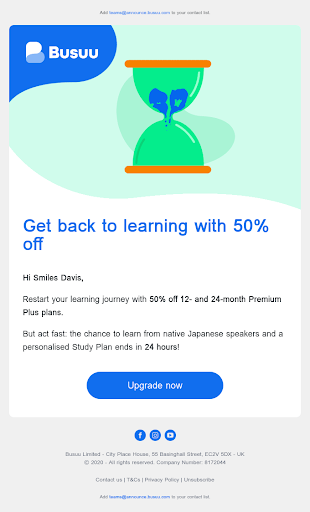
7. Birthday and Anniversary Emails
Marking personal achievements with your clients can turn your brand into a business with a heart. Birthday and anniversary emails aren’t just automated greetings; they are a chance to establish a real bond with your audience. Personalization is important in this case – it is about seeing and honoring the person, not just sending a standard message.
The magic of these special occasion emails is in the details. Think of an email that greets you on your birthday and also contains a small historical review of what you have done together in the past with a specific brand. For example, a bookstore may suggest books that are similar to those you have purchased before, as well as a special birthday discount. It’s thoughtful, appropriate, and demonstrates that the brand is interested.
On the other hand, anniversary emails commemorate the bond between the customer and the brand. This is a good chance for remembering and thanking. For instance, an email that reads, “It’s been a year since you’ve joined our family! Here’s a look back at some of the great decisions you’ve made” and is followed by a custom collage of past purchases that would evoke a feeling of nostalgia and belonging.
The main key to successful birthday and anniversary campaigns is to find a proper balance between the celebratory message and gentle marketing. A small token such as a particular discount code or a freebie on their next purchase can make a big difference. It’s not only about selling but about making them to celebrate with your brand.
The thing is that everybody wants to feel special on their birthday or anniversary. Making emails personal for these occasions will help you build a stronger bond with your customers. And when executed properly, such campaigns can make a particular day a special buy.
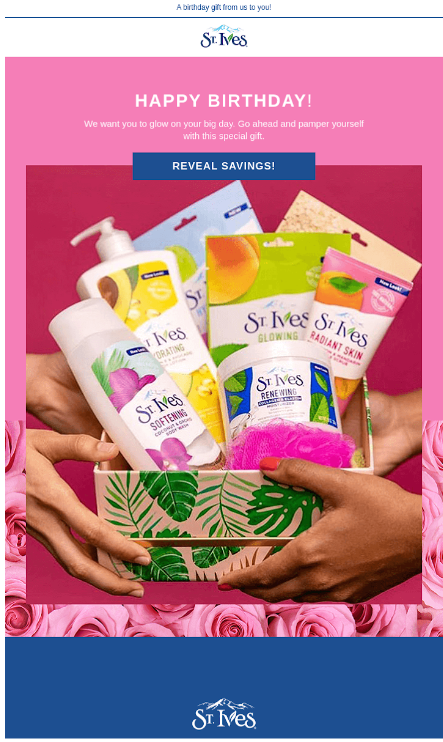
8. Product Launch Emails
A new product launch is similar to revealing a new page in your brand’s story and the launch email is of great importance in this happy event. Creating a successful product launch email is all about achieving the right harmony between information, engagement, and persuasion.
- For the product launch email to be outstanding, begin with an attention-grabbing subject line. This is your elevator pitch and it has to be interesting enough to make an impresson. Consider it as your product’s story headline – it should matter.
- Then, concentrate on the email body. In this case, clarity and brevity are your best friends. Tell a story about your product when launching it. For what purpose did you make it? What does it solve? Where does it fit into or how does it improve the life of your customers? Create an image which situates your product within your audience’s daily life or problems.
- A picture is worth a thousand words, especially in a product launch email. Incorporate good quality pictures or videos of your product that present it in an excellent light. The visuals should not only show the product but also convey the lifestyle or benefits related to it.
- Remember to stress the USPs. What is unique about your product? Be clear – whether it is a unique feature, an unmatched price, or an ethical production process, ensure that your USPs stand out.
- A powerful call-to-action (CTA) is a must. Whether it’s to get the recipients to learn more, view a demo or make a purchase, your CTA should be obvious, convincing, and easy to locate. Lead your readers with certainty on what to do next.
- Customer testimonials or endorsements included in your launch email can increase credibility by a great deal. If you have beta testers or early adopters who have used your product, their positive reviews are very convincing in influencing other people.
- Timing is everything. Your product launch email should be timed with other marketing activities and larger industry events or seasons when your product will be most relevant.
A powerful product launch email can establish the mood for the market entry of your product. You get to make an event of it, generate some buzz, and set the stage for future marketing campaigns. A good email should achieve website traffic, increase social media activity, and, in the end, increase sales.
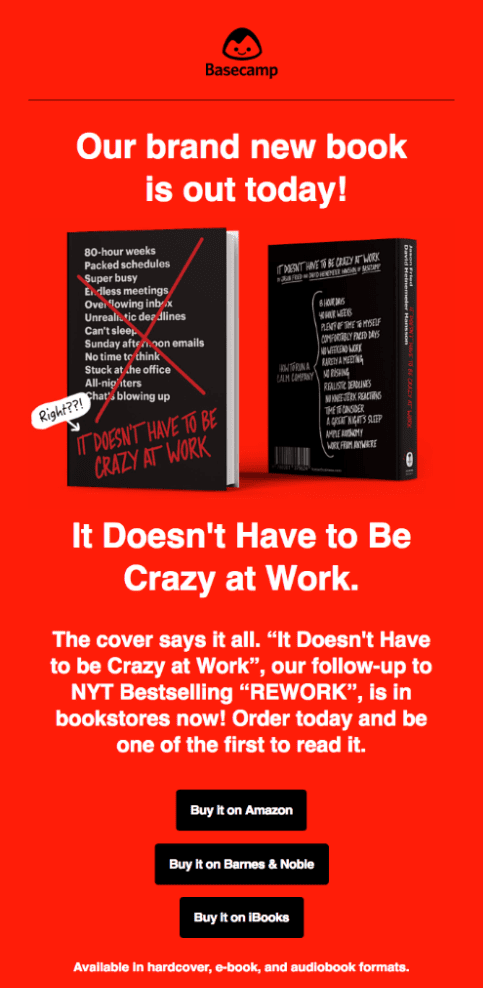
9. Event-Triggered Emails
Event-triggered emails are one of the dynamic parts of modern email marketing, which provides the opportunity to be active upon customer actions. This method turns generic email campaigns into actual personalized conversations, thus taking the customer experience to a whole new level.
The essence of an event-triggered email is that it is an automatic email sent in response to a customer’s specific action or behavior. These activities can be as simple as visiting a specific web page, purchasing something, abandoning a shopping cart, or even just browsing a product sub-category. Every event is linked to an email that is personalized to capture the customer at a time when they are likely to be more responsive.
The magic of event-triggered emails is in their relevance and timeliness. These emails directly follow the user behavior and are much more engaging and impactful than the traditional email campaigns.
Invitation emails typically encompass these key elements:
- Set Event Dates: Fixed dates help in scheduling the event for the attendees. Precise information about the timing of the event guarantees that the possible participants can schedule themselves and prepare for being involved in it.
- RSVP or Registration Option: RSVP or registration option for recipients is also quite essential. This feature is not only useful for the purpose of planning and organizing the event but also creates a sense of commitment and participation among the attendees.
- Compelling Value Proposition: Defining the advantages of the event is crucial. When you detail what the attendees receive, be it knowledge, networking, or fun, you make them aware of the main takeaways and reasons as to why they should attend.
- Guest Speaker or Content Creator Details: Noting well-known guest speakers or content creators makes the event more credible and more appealing. Clearly identifying these people along with their expertise or accomplishments can raise the attractiveness of the event, hence, increasing the number of attendees.
Incorporating these components in an invitation email effectively communicates essential details, motivates potential attendees, and enhances the appeal of the event.
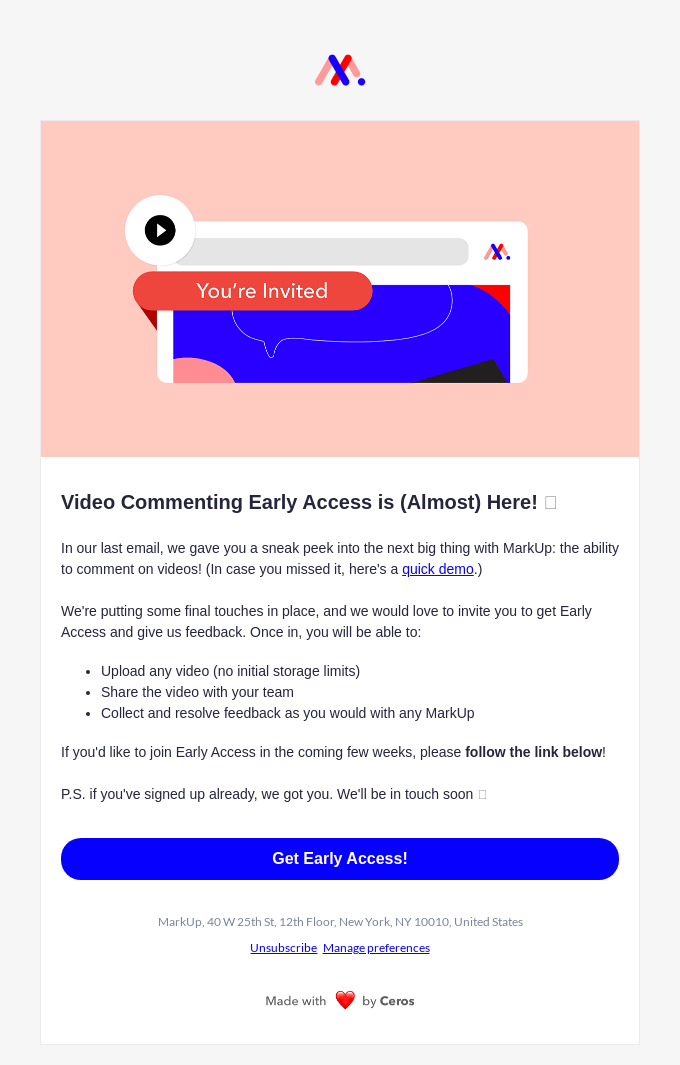
10. Review Request Emails
The customer voice is more powerful than ever. Here is where the science of creating enticing Review Request Emails comes in. These emails are not just paperwork; they are a perfect chance to interact with your consumers and collect the insights that may push your brand further.
Your review request email can be structured as follows:
- Impact on Product Development: Advise your clients that their opinions will have a powerful influence on the future product development. This approach makes them feel that their opinions do matter and can result in actual changes in your offerings.
- Enhancing Product Recommendations: Detail how their reviews will help to generate more precise product suggestions. This is a win-win situation for both the employee and the customer.
- Influence on Other Buyers: Emphasize that their reviews can help other customers to make informed decisions and boost the growth of your brand. This fosters a feeling of togetherness and a common goal.
- Community Engagement: Promote customer engagement in community discussions. This not only brings more varied feedback but also creates a sense of unity and involvement with your brand.
- Incentives for Reviews: Give an incentive to write a review, like a gift card or a discount coupon. This acts as a real appreciation for their time and effort in giving feedback.
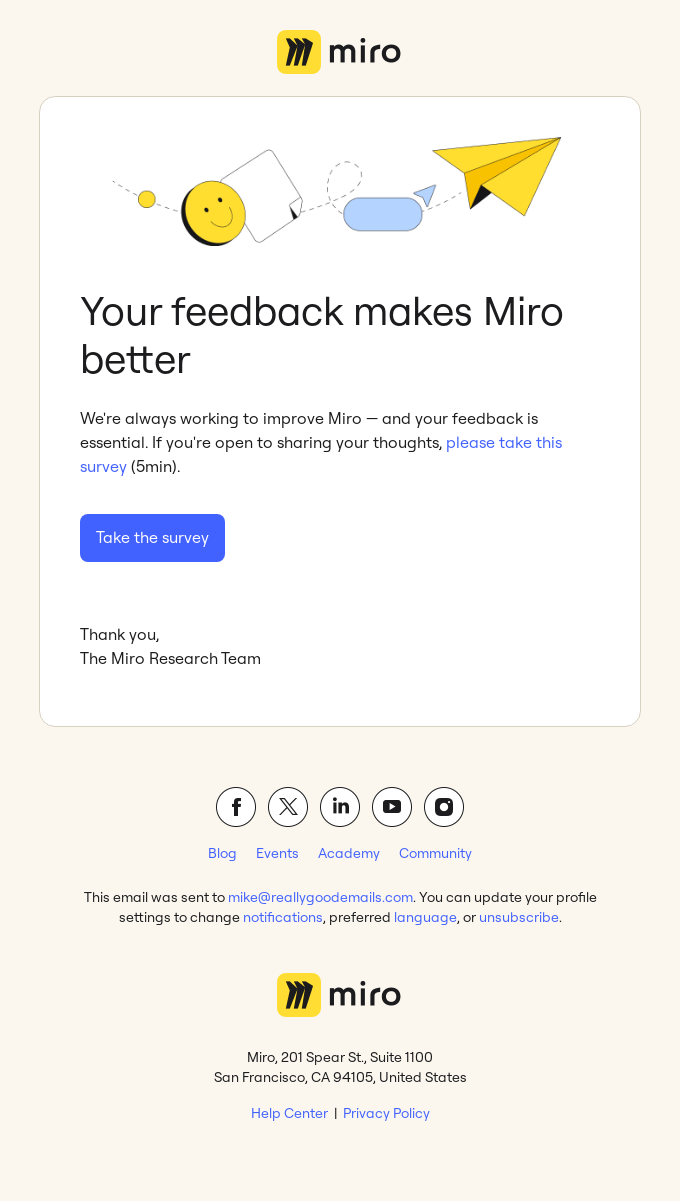
11. Post-Purchase Emails
These emails are not just a polite “thank you” after a sale; they are a crucial instrument for customer satisfaction and the foundation for repeat purchases.
The significance of post-sale communication cannot be over-emphasized. This is the stage at which a customer’s interaction with a product or service is formed. Good post-purchase emails are not only a transaction confirmation, they also improve the customer experience, provide useful information and allow for further interaction. They are a brand’s chance to move from a seller to a trusted authority.
Common types of post-purchase emails typically feature:
- Buy Recommendations: These emails provide recommendations of other products related to the product that the customer recently purchased, and they are all about making the shopping experience even more personalized by giving the customer the right choices.
- Personalized Discounts: The provision of exclusive discounts in these emails promotes repeat purchases by making customers feel appreciated and acknowledged for their loyalty.
- Special Bundle Deals: Customized bundle offers that are intended to match the customer’s preferences and past buys offer an appealing reason to engage with the brand more.

12. Educational Content Emails
Standing out is not only about selling products or services but is also about positioning your brand as the reference resource. Educational content emails come into their own here. They’re no ordinary marketing emails! They are a source of wisdom shared right to your target audience.
- Enriching Your Audience with Knowledge: Picture your subscribers looking forward to receiving your emails, not because they anticipate a sales pitch, but because they know they will get something useful from you. Emails containing educational content are basically mini-seminars that arrive in people’s email boxes, sharing insights, tips, and expertise. Whether it is a comprehensive overview of the industry, a how-to guide, or practical advice, these emails make your brand a place of knowledge and competence.
- Building a Relationship Beyond Transactions: You are giving without receiving anything in return when you share information. Such an approach creates trust and respect. Your audience starts seeing you not only as a seller but as a tutor and consultant. In a world where consumers face an avalanche of selling messages, educational content is a breeze of fresh air.
- Establishing Brand Authority: Consistently delivering informative and relevant content makes your brand an authority in your field. Not a matter of blowing your own trumpet, but rather of proving that you are competent. Saying you are an expert is one thing, but demonstrating it with every email you send is a different story.
- Creating Content That Resonates: What makes educational content successful is its relevance. Know what your target market would like to know about. Plunge into their problems, hobbies, and desires. Customize your content to not only educate but also to address their unwritten inquiries. Keep in mind that the more your content will resonate with them, the more they will see your brand as an authority.

13. Replenishment Reminders
Keeping your product on top of your customers’ minds is a critical thing, particularly when it comes to products they use regularly. This is where replenishment reminders step in to help: a smart solution to make sure your customers will never run out of the products they like.
- Tailoring to Product Usage Cycles: Every product has a lifecycle and the understanding of this is crucial to the proper functioning of the replenishment reminders. When you schedule your reminders to coincide with these usage cycles, you are providing a useful service to your customers. It is more about providing the convenience, so that they do not need to remember when to reorder. This does not only improve the level of customer satisfaction but also the probability of the repeated sale.
- Beyond the Reminder: Replenishment reminders are not just a push to buy, they are a chance to build customer loyalty.
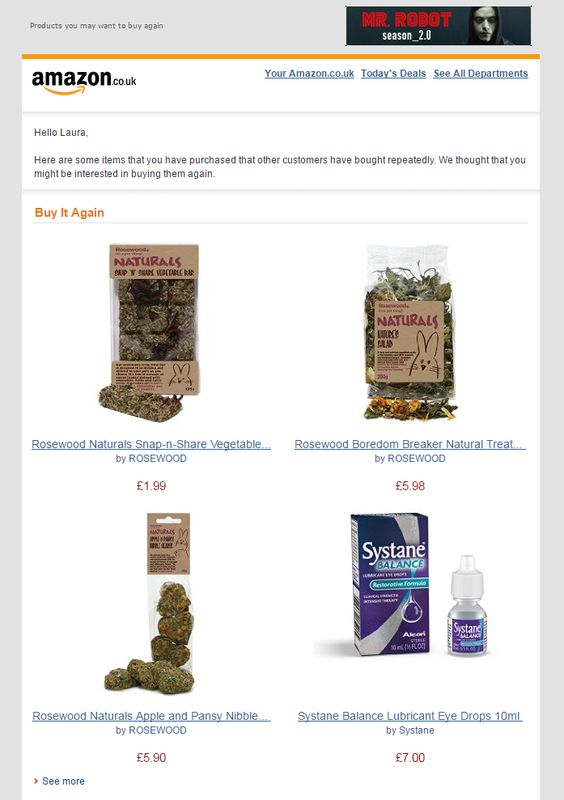
14. Cross-Sell & Upsell Emails
Cross-sell and upsell emails are tactical marketing messages intended to increase sales. They differ slightly in their approach:
Cross-sell emails propose products or services that are related to a customer’s recent purchase or interest.
Upsell emails are meant to convince the customer to buy a better version of what they are interested in or have already bought.
To maximize the effectiveness of cross-sell and upsell emails, consider these strategies:
- Personalization: Customize recommendations according to the customer’s purchase history, browsing behavior, or preferences. Customized suggestions are more attractive to the customers and, thus, they are more likely to make one more purchase.
- Timing and Relevance: Time these emails when they are appropriate. Cross-selling is best immediately after a purchase. Upselling opportunities should be seized when a customer is on the verge of making a purchase or is interested in a certain category.
- Clear Value Proposition: Highlight the advantages of the recommended products or upgrades. Describe how they can complete or improve the customer’s initial selection.
- Attractive Presentation: Employ attractive visuals and simple, short statements for a proper presentation of the products. Attractive email designs can have a significant impact on customer interest and decision-making.
- Limited-Time Offers: Generate urgency with deals that are time-sensitive or with exclusive offers for upgrades and supplementary purchases.This encourages quicker decision-making.
- Ease of Purchase: Provide direct links to the products and a clear purchase process. Simplifying the buying journey can improve conversion rates.
Through these components, cross-sell and upsell emails will improve sales and customer experience.
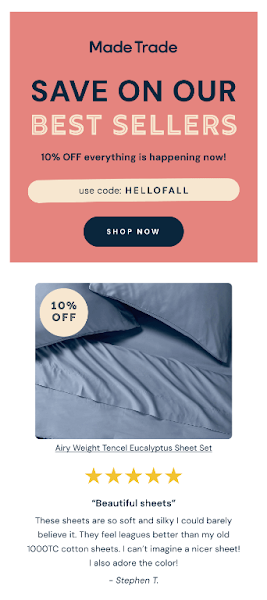
15. Loyalty or Reward Program Emails
Customer retention can be fully realized only through a strategic approach which rewards and respects the loyalty of the customers rather than through mere regular interaction. This is when the potential of Loyalty Program emails comes to the surface. In the digital era, emails are not mere words; they are a direct way to the preferences and interests of your clients.
The key features should include:
- Instant Incentives and Time-Sensitive Deals: Provide immediate benefits to customers. For example, special discounts or time-limited promotions. The immediate benefits of these perks are attention and gratitude.
- Ongoing Advantages: Offer long-term benefits including significant price reductions, free shipping, and members-only specials. Such ongoing benefits nurture the customers’ loyalty for life.
- Reward Targets for Regular Buyers: Set spending goals for loyal customers that are tied to certain rewards or a points system that can be traded in. This approach promotes continuous purchasing and loyalty.
- Exclusive Contests and Draws: Attract clients to participate in the loyalty program using exclusive prizes and raffles. Such exclusive opportunities generate interest and a feeling of exclusiveness.
- Engaging Competitions with Coveted Prizes: Run fun competitions with prizes that are in high demand. Competitions of such kind promote involvement and maintain the audience’s interest in your brand.
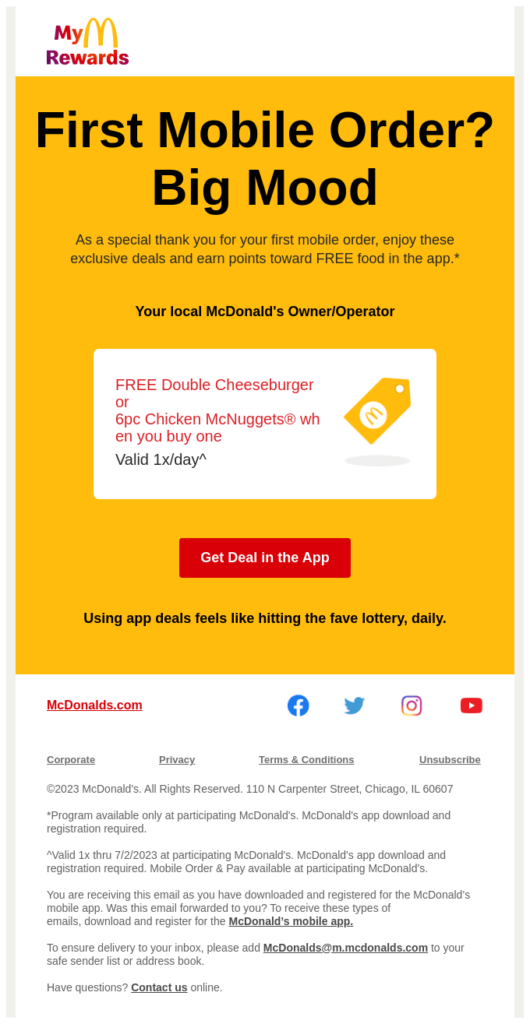
16. Referral Program Emails
Referral program emails are one of the key tools in the marketing armory, acting as a link between your loyal customers and their networks. When you motivate your existing customers to recommend friends or family, you are not only growing your reach but also creating a community around your brand.
- Crafting the Perfect Referral Email: The secret of a successful referral email is to make it appealing to your target market. This also means hitting the right balance between informative and interesting. Your email should be able to clearly state the advantages of your referral program to both the referrer and the referee. It is more than just informing them about the program; it is about demonstrating why it is important.
- Designing Attractive Referral Incentives: Incentives are the lifeblood of any referral program. They need to be persuasive to make your customers act! The incentive can take the form of a discount, a free product, or exclusive access to new offerings, and it should be of significant value to your audience. However, it is not all about the reward. It is about your customers, who feel that they are sharing something really valuable with their friends and relatives.
- Creating a Continuous Loop of Engagement: The final aim of referral program emails is to create a self-perpetuating cycle of engagement, where each referral brings in new customers, who will also become referrers in the end. It’s not only about growing numbers; it’s also about developing a community that appreciates and promotes your brand. With Sendpad’s analytical instruments, you can constantly improve your strategy on the basis of actual data which means that your referral program will remain efficient and up to date.
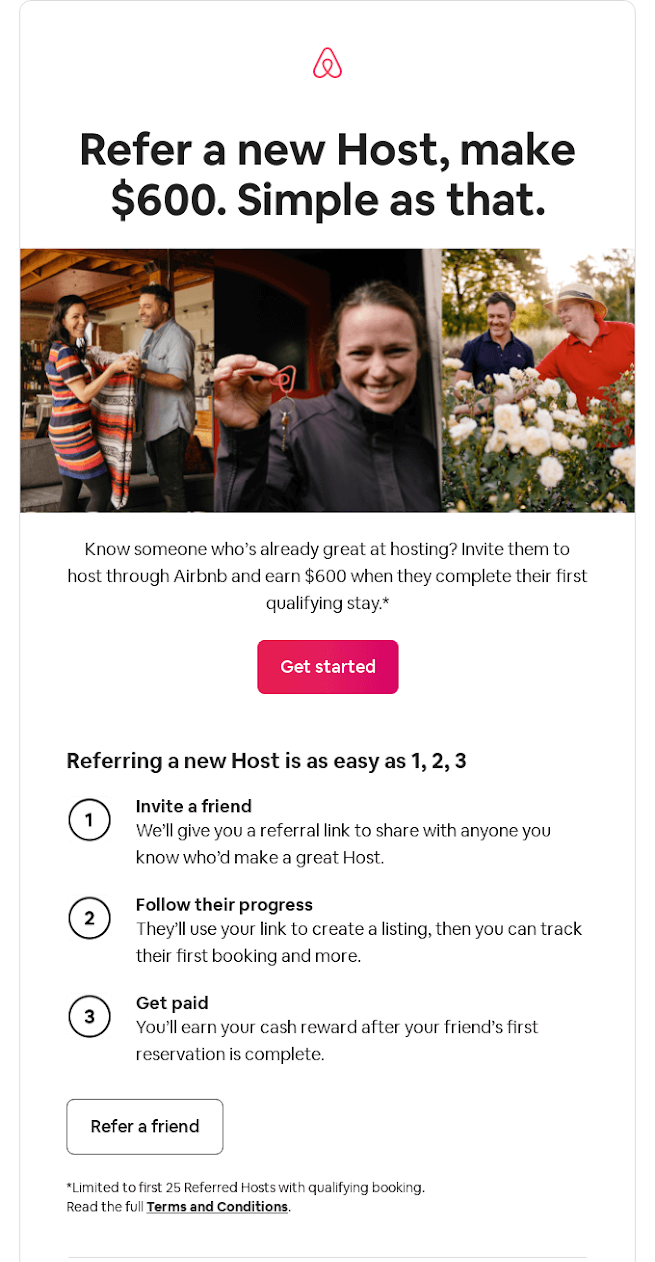
17. Flash Sale Announcements
Flash sales are the adrenaline shots in the world of email marketing. They are swift, rabid, and ridiculously efficient in generating instant action. However, for these systems to be really efficient, you need a sharp strategy.
- Crafting the Perfect Flash Sale Announcement: A successful flash sale email is characterized by its ability to catch the reader’s attention immediately. You want your customers to enjoy the buzz of a good deal that is there for a while and not forever. Kick off with a subject line that’s a total showstopper. Think “Flash Sale Alert: “50% Off for 24 Hours Only!” It’s not a notification, but an invitation to a special occasion.
- Creating Urgency: Nothing says ‘act now’ like a ticking clock. Add a timer to your email that will show the remaining time visually. This constant time pressure forces your customer to click that ‘buy now’ button.
- Balancing Urgency with Value: Urgency itself is not sufficient! Your flash sale must provide some real value. Emphasize on the advantages of the product or service being offered. Whether it is a perfect winter coat at a fraction of the cost or a luxurious spa experience for half the usual price, ensure that your customers are aware of the great deal they are getting.
- Personalization: The Secret Ingredient. Personalization could turn your flash sale from good to great. Segment email content based on customer data. If you know that a customer has been eyeing a certain item, inform them that it is now available at a discounted price. Such a level of individual approach not only raises the probability of a purchase, but also develops customer loyalty.
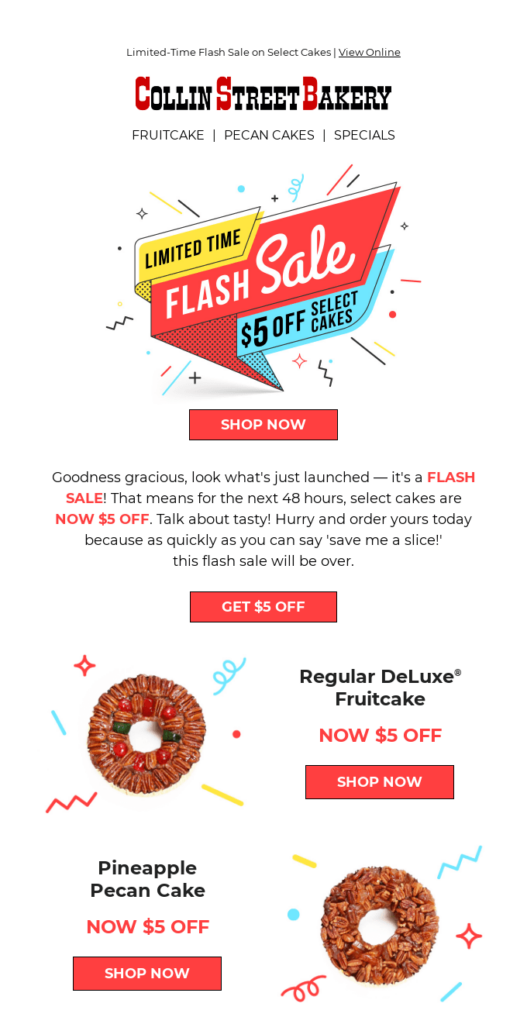
18. Back-in-Stock Notifications
Imagine the scenario: A visitor comes to your site, discovers the perfect item, only to find out that it’s out of stock. It happens all the time, but with back-in-stock notifications, it’s also a golden opportunity. Not only are they a courtesy, these notifications are the perfect instrument to re-sell and keep the interest of the customer.
Basically, the back-in-stock notifications are the automated emails that are sent when the out-of-stock item becomes available. The idea is a simple one, but its strength is in the immediacy and relevance. A customer subscribing to these alerts shows an obvious interest in your product. A quick response to this interest not only improves the chances of a sale but also increases the customer’s satisfaction with your brand.
But here’s the twist: It is not only about informing, it is about activating. These notifications need to be designed in a way to prompt quick reaction. Here is where the skill of persuasion plays a role. A good back-in-stock email should instill a sense of urgency. Words such as “Limited availability” or “Selling fast” can push the buyer to take quick action.
To ensure your customers feel informed and comfortable, remember to add these elements to your inventory update emails:
- Refer to Past Shopping Behavior: Identify which back-in-stock items they may be interested in by using customers’ past purchases or browsing history. This individualized manner indicates their respect for their tastes.
- Clarify Purchase Availability: Notify customers if they can make an immediate purchase of the back-in-stock items or if there is a time frame that they should wait to place orders. Clarity in communication regarding this issues creates the correct expectations.
- Offer Pre-Order or Waitlist Options: In case of limited stock, allow your customers to pre-order or to join the waitlist. This alternative guarantees that they do not lose out on items they are interested in and shows that you are dedicated to satisfying their needs.
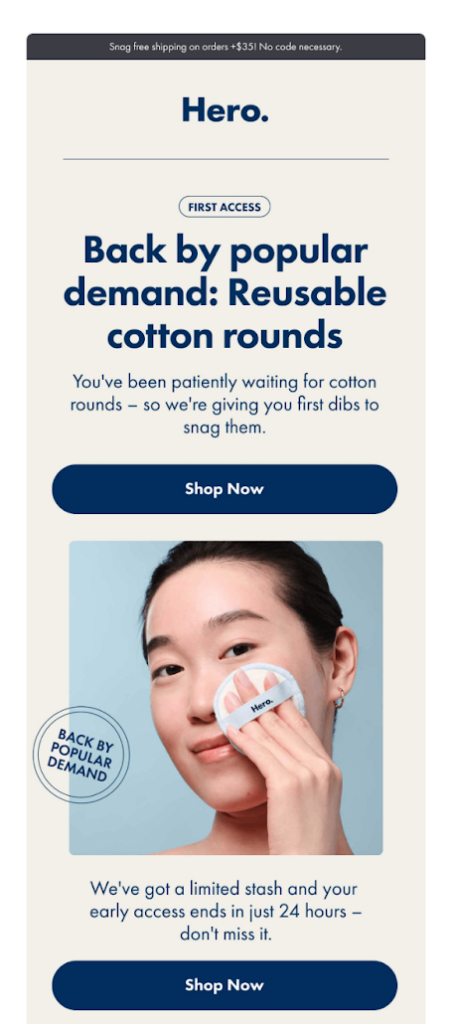
19. Policy Update Emails
Policy update emails are not just written contracts, but rather, they are a way to develop a relationship of trust and transparency with your subscribers. These updates are not only about compliance with legal obligations but about appreciating and honoring the relationship with the audience.
In crafting policy update emails, clarity is the king. The language should be plain and without any jargon, so that subscribers could follow the changes and how they might influence them. The need is to maintain a balance between being informative and brief, which would avoid unnecessary complexity that might result in confusion or misinterpretation.
Tone is an important part of these emails. Although the professional attitude should be preserved, a little bit of warmth and friendliness can be of great help. This friendly tone aids in making sure that these updates are a part of a continuous dialogue, not an one-way message.
Furthermore, it is important to stress the advantages or causes of these changes. Be it an enrichment of the user experience, an enhancement of services, or an increase in safety, informing the subscribers about the ‘why’ of changes can develop comprehension and acceptance.
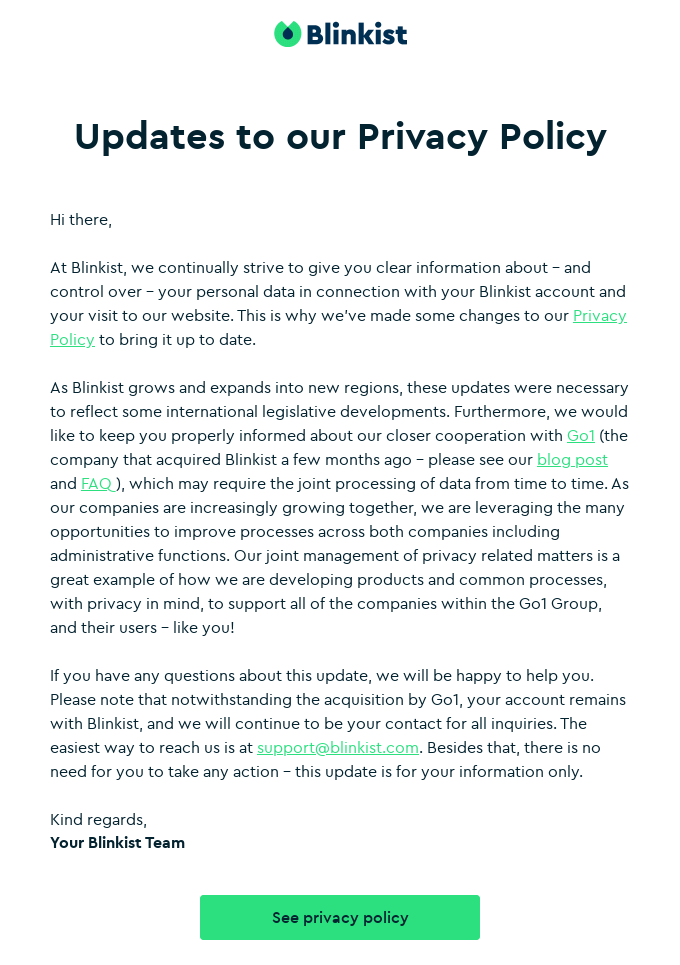
Integrate Automated Email Campaigns with Sendpad Platform
In what way does integrating email automation with Sendpad will change your marketing approach?
Seamless Integration for Efficient Campaign Management
SendPad’s beauty is in its ability to seamlessly integrate. You only need a few clicks to sync your customer data and begin developing personalized email campaigns.
Personalization at its Best
Personalization rules in the world of email marketing. Sendpad is very effective in this area, enabling you to divide your audience according to the different criteria such as purchase history, preferences, and behavior.
Automated Workflows to Save Time and Increase Productivity
Automated workflows are among Sendpad’s most notable features. Triggers can be set based on particular customer activities such as website visits or previous purchases, which will result in the sending of relevant emails automatically.
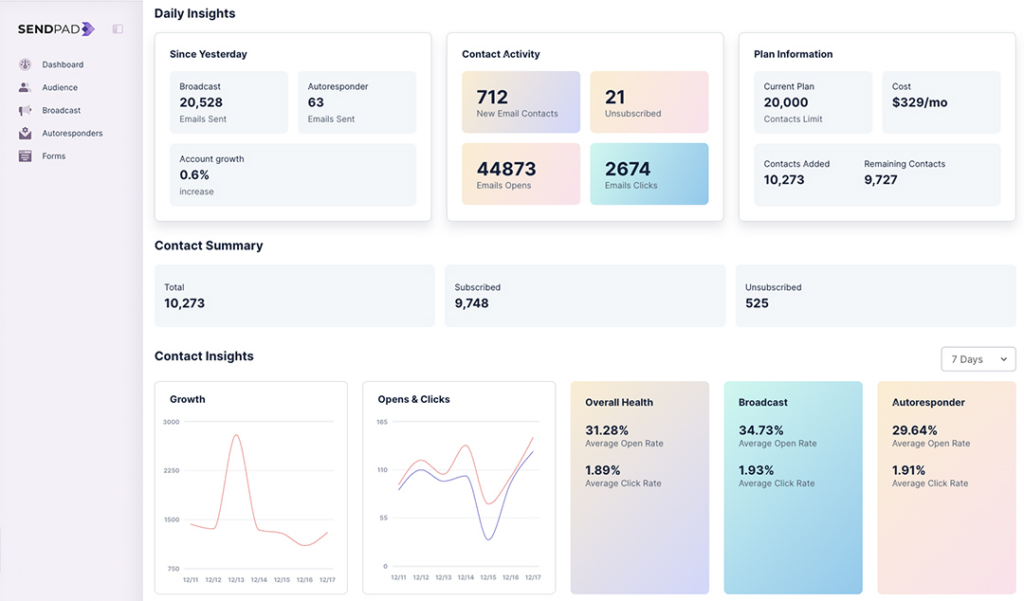
Analytics and Reporting for Informed Decisions
Sendpad offers detailed analytics and reporting features that allow you to see opening rates, click-through rates, and overall campaign results.
Responsive Design for Optimal Viewing Experience
With Sendpad, your emails will look fabulous on any screen, a fact that is important in an era when emails are read on mobile devices often.
Scalability for Growing Businesses
Sendpad is designed to grow with your business, providing features and plans that fit different sizes and types of businesses.
Enhanced Customer Engagement Through Interactive Content
Sendpad goes beyond email sending; it’s about sending experiences. Through functions that enable interactive content like polls, surveys, and dynamic images, your emails can turn into a dialogue with your audience.
Compliance and Security: A Top Priority
In this age of increased data privacy concerns, Sendpad guarantees that your email campaigns adhere to laws such as GDPR.
User-Friendly Interface for Quick Learning Curve
The platform is easy to use for everyone due to its friendly interface and intuitive design.
Dedicated Support for Uninterrupted Campaigns
Finally, the support Sendpad supplies is impressive. Having a special support team, you can get help anytime you want making sure that your email campaigns are going smoothly without any problems.
Conclusion
Each type of automated email campaign play a distinct and important role, from the first welcome email that establishes the stage for future interactions to special campaigns such as cart abandonment and post-purchase follow-ups. They are the cornerstones of a strong digital marketing plan, providing companies with the tools to communicate, develop relationships, and convert.
Automation in email marketing is invaluable. Tools like Sendpad make this process not only easier but also more effective. Sendpad’s platform provides the kind of intuitiveness and effectiveness that turns email marketing into an opportunity. It allows the marketers to develop, control and optimize different types of automated email campaigns easily so that each message is not only timely but also relevant to the target audience.
Marketers interested in taking their email marketing strategies to another level should focus on trying out different kinds of automated campaigns. And with Sendpad, this trial and error approach turns into a fun adventure.


